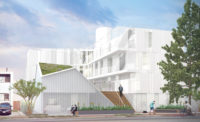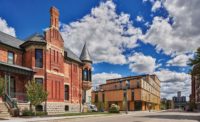Mariposa 1038 by Lorcan O’Herlihy Architects
Los Angeles

The main facade of the 68,000-square-foot building addresses Mariposa Avenue with a lively composition of projecting balconies and window frames. While other buildings on the block have walls or fences in front, Mariposa 1038 invites pedestrians to sit on low planters and perhaps engage residents in conversation.
Photo © Paul Vu

Oak paneling and clerestory windows add warmth and daylight to the double-height lobby.
Photo © Paul Vu

On the roof, redwood decking, planters, and comfortable seating create a casual place for residents to socialize and enjoy views of Koreatown and surrounding areas.
Photo © Paul Vu

Closets in the bedroom help define a “flex space” that can be used as an office or a sitting area.
Photo © Paul Vu

Open layouts and exposures on at least two sides facilitate cross ventilation in all apartments.
Photo © Paul Vu

Residents access their units from a central courtyard that offers seating and a planter that captures rainwater for use in irrigation.
Photo © Paul Vu

Image courtesy Lorcan O’Herlihy Architects

Image courtesy Lorcan O’Herlihy Architects

Image courtesy Lorcan O’Herlihy Architects

Image courtesy Lorcan O’Herlihy Architects










Architects & Firms
Taking the old cliché literally, Lorcan O’Herlihy pushed the envelope of Mariposa 1038, his new multifamily housing project in Los Angeles, to create concave facades on all four sides. This simple act of indenting the perimeter so it bows in at the middle like a pillow that has been slept on allowed the architect to animate the elevations and change the building’s relationship to its neighbors. By establishing a curving outdoor space between the sidewalk and the apartment block, he provides a third zone that sits on private property but opens to the public. The building, with four full residential floors above grade, has balconies and window frames that project out to fill the space with a syncopated rhythm of black and white shading devices. The framing boxes in the center of the facade extend out 30 inches—the same depth as the curve—while those at the ends are flush with the building wall.
For more than two decades, O’Herlihy has been exploring what he calls “amplified urbanism,” often using private development to engage the public realm. For example, at his Formosa 1140 condo project in West Hollywood (RECORD, July 2010), he convinced the private client to devote a third of the property to a publicly managed pocket park, a feature that adds value to both the apartments and the city. At Mariposa 1038, the gesture is less dramatic—with a 15-foot semi-public space between the sidewalk and building—but equally welcoming, especially since the project is in Koreatown, Los Angeles’s most densely populated neighborhood at 42,600 residents per square mile.
Additional Content:
Jump to credits & specifications
Aimed at young professionals, Mariposa 1038 offers 32 market-rate rental apartments, divided evenly between one- and two-bedroom units. The typical one-bedroom unit is 880 square feet and has a “flex space” in the bedroom that can be used for a home office, a sitting room, or a play space. The typical two-bedroom unit has 1,250 square feet and two bathrooms. The city’s zoning ordinance required 67 parking spaces, which are provided on the ground and basement levels. Anticipating a change in requirements due to the growing popularity of car-sharing programs, O’Herlihy designed the ground-floor parking so it opens onto a strip of outdoor space in the rear and can be converted, at least in part, to a programmable area for exercise or recreation. As is typical for this kind of multifamily building in Los Angeles, the foundation and first floor are poured concrete, while everything above is wood-frame, Type-V construction covered in raked plaster.
Playing off the gentle bow of the exterior envelope, O’Herlihy scooped out a curving courtyard in the middle of the building and ringed it with outdoor corridors providing access to the apartments. The courtyard brings daylight and cool air into the dwelling units, all of which take advantage of cross ventilation to reduce the need for air-conditioning. At the base of the courtyard—on the second floor—a planter captures rainwater for use in irrigation and, in the process, reduces stormwater runoff. A built-in bench hugging the planter turns the outdoor space into a social hub for residents, while the balustrades above form a sinuous ribbon that draws the eye to the roof, where a landscaped redwood deck with seating areas and planters serves as another spot for gatherings.
The apartments all have 10-foot ceilings, open kitchens, and some floor-to-ceiling glazing to make them feel more spacious. While the interior finishes, such as engineered-oak floors, manufactured-stone counters, and walk-in closets with pocket doors, are nothing fancy, they have clean modern lines that give them a stylish look.
The client, a first-time developer who is a lawyer by profession, approached O’Herlihy, asking for a design that would set the building apart from the usual housing product on the market. “She knew my work and was open to new ideas,” says the architect. Even with its innovations, he delivered a project that cost about $190 per square foot to build, a low figure for the city, with the apartments renting for between $2,400 and $3,400. On a tour of the building in late August, this writer spoke with a few residents in their late 20s and early 30s who were attracted to the architecture and the growing food scene in newly fashionable Koreatown.
Although the building doesn’t use any alternative energy sources, it employs a number of passive-design strategies that include the sunshading frames around windows and balconies, the rainwater recycling in the courtyard, LED lighting, the reflective plaster skin, and apartment layouts that facilitate cross ventilation with exposure on two sides.
The architect, who has designed multifamily housing for two decades and is currently working on a project for the formerly homeless in South L.A., feels that housing should be at the center of the architectural conversation in Los Angeles. “I’m interested in the social and civic aspects of these projects,” says O’Herlihy. “We need to create new models for connecting residents to each other and to the rest of the city.”
CreditsArchitect: Lorcan O’Herlihy Architects, 4106 West Jefferson Blvd., Los Angeles, CA 90016, 310.657.4363 www.loharchitects.com
Personnel in architect's firm who should receive special credit: Lorcan O’Herlihy (Principal-in-Charge), Nick Hopson (PD), Alex Anamos, Dana Lydon, Donnie Schmidt, Jessica Colangelo, Jennie Matusova
Engineers Structural: Amir Pirbadian INC. MEP Engineer: Budlong and Associates Civil: Harvey Goodman Civil Engineering, Inc. Geotechnical: Geocon West, Inc.
Consultants Lighting: Guy Smith Architectural Lighting Landscape: LINK Landscape
General contractor: Fortis 17 CRM Corporation
Photographer: Paul Vu
|
SpecificationsStructural System Tie Down System: Earthbound
Roofing Built-up roofing: GAF Elastomeric: Miracote
Windows Metal frame: Milgard
Glazing Skylights: Velux
Doors Entrances: Metal doors: Wood doors: Sliding doors: Fire-control doors, security grilles: Special doors: Upswinging doors, other:
Interior Finishes Cabinetwork and custom woodwork: Modulo Cucine
Conveyance Elevators/escalators: Otis Elevator Company |
















